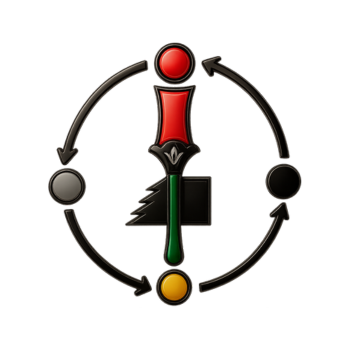-
Numbers in regard to symbolism has a much deeper meaning than simply their numerical value. Numbers has expressed ideas and much of what passes for historical stories are really an inner understanding of deeper beliefs. Mythlogies contain symbols that can be seen and sometimes handled and used to make visible an invisible truth or belief held important by the society. Quite often in Afrika numbers are related to gender. However, the assigning of a specific number to either of the sexes is by no means universal. Some cultures denote masculinity by an odd number and femininity by an even number. Other cultures assign even numbers to males and odd numbers to females.
The meanings of the number 2 for example in the culture of North Eritrea, the number 2 is assigned to woman. This number has an important meaning throughout Afrika. In ancient Afrikan religions, this number signified two planes. One was conceptual, and the other was a plane of action. This idea is expressed in practice by accepting the Creator in concept only, while another Being is recognised as the controller in the affairs of the world and is treated as such in the religious services.
Twin births are received very differently by different people, but never go acknowledged. For the Sango of the Eastern Ubangui, this is the cause for great celebration that continues throughout the lives of twins. But a much harsher reality unfortunately awaits twins born among the Diola, where only one is allowed to survive. The Ibo is said to consider the birth of twins as an evil omen, and frequently none are allowed to survive. The Miseke of Luanda believe that twins do possess magical powers, and for this reason, they receive great respect.
Other examples of the varied usage of the number 2 are the Khen and Jippur which are the names of the two social groups of the Angas. The Lala celebrate female puberty with 2 days of dance. The Yoruba describe two types of married women: the old and the young. Two groups of ancestral spirits are revered by the Mende. The Wapogoros identify two types of spirit: the bad and the good. A secret language is used by the Balovale for initiations and funerals.
The Ibo god Ikenga is shown with two half moon shaped horns. Two animals are sacrificed on the second day of a Makhanya wedding. Certain Kongo people bury their deceased in two stages. The Kikuyu and Kamba use red and black on their shields. For the Shilucks, it is the aunt’s responsibility to gift two cattle to the dowry of her nephew’s soon-to-be wife. The Togos shape their teeth so that each has two points.
Ajagbo, a Yoruba God is represented as a double image. Nigerian jewelry is often made up of two figures, masculine and feminine, mounted on a chain. Bideyogo paintings often show the number 2 as two women, two men, two youths, two bulls or two of anything in an activity. Further, the Kimbundu do not announce the death of their great chief for 2 days. The body is attended to by four diginitaries and is allowed to dry for 2 years. The Ovibundu chiefs are buried in a way that allows acess to only two people. The Fali say that the world was born from two eggs: one from a toad and the other from a turtle.
3 Comments-
Meda ase for this.
-
Goddess you are so very welcome. Thank you as always as I keep on repeatedly saying (as I sound like a broken record) but I truly appreciate your valued time to read…blessings always.
-
I SO APPRECIATE your scholarship- the content is ALWAYS relevant and fascinating. …and your PHOTOS…👏🏾👏🏾
-
-

